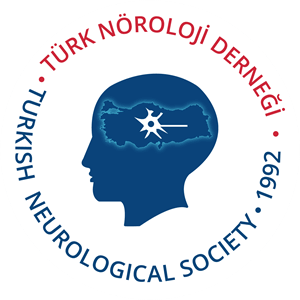Management of neuroleptic malignant syndrome induced by paliperidone: A case report of multidisciplinary treatment approaches, including apomorphine and electroconvulsive therapy
Murat Gültekin1 , Şeyma Benli2
, Şeyma Benli2 , Saliha Demirel Özsoy3
, Saliha Demirel Özsoy3 , Yıldız Değirmenci4
, Yıldız Değirmenci4
1Department of Neurology, Erciyes University, School of Medicine, Kayseri, Türkiye
2Department of Neurology, Afşin State Hospital, Kahramanmaraş, Türkiye
3Department of Psychiatry, Erciyes University Faculty of Medicine, Kayseri, Türkiye
4Department of Neurology, İstanbul Health and Technology University Medical Faculty, İstanbul, Türkiye
Introduction
A 34-year-old female patient with a history of bipolar affective disorder, who had been receiving paliperidone 100 mg monthly and biperiden 3 mg daily for the past two years, was admitted to the emergency department with a three-day history of fever, altered consciousness, dysphagia, mutism, rigidity, inability to walk, inability to speak, and vacant, meaningless stares. It was noted that her last paliperidone injection was administered 12 days before the hospitalization. Vital signs revealed a fever of 38.1°C, mild tachycardia, and normal blood pressure. Laboratory tests indicated leukocytosis and an elevated serum creatine kinase (CK) level of 1098 U/L (normal range: 39-308 U/L), suggesting muscle breakdown. Neurological examination revealed excessive sweating, confusion, rigidity, and dysphagia. A written informed consent was obtained from the patient.
The patient was admitted to the intensive care unit (ICU) with a suspected diagnosis of neuroleptic malignant syndrome (NMS). To exclude other potential causes, a contrastenhanced brain magnetic resonance imaging, electroencephalography, and lumbar puncture were performed, none of which indicated central nervous system infection. In the ICU, treatment included fluid infusion, antipyretic therapy, amantadine (100 mg three times daily), and intravenous diazepam (10 mg three times daily). The patient’s fever, leukocytosis, and CK levels improved, but rigidity persisted. Consequently, amantadine was switched from oral to intravenous administration, and diazepam was discontinued. Lorazepam (0.5 mg three times daily) and bromocriptine (5 mg three times daily) were added to the treatment regimen. However, during the ICU follow-up, an increase in the patient's creatinine levels was observed, prompting the discontinuation of amantadine.
Approximately two weeks later, due to persistent parkinsonism symptoms, the patient was started on domperidone (10 mg three times daily) and subcutaneous apomorphine infusion. Significant improvement in rigidity was observed, and the patient regained the ability to take oral nutrition. The patient’s fever resolved, tachycardia subsided, and the bromocriptine dose was increased to 7.5 mg three times daily. Two weeks after the initiation of apomorphine infusion, the patient's body movements transitioned to catatonia, accompanied by negativism and mutism, raising concerns about catatonic schizophrenia. Consequently, the patient was referred to the psychiatry clinic with a preliminary diagnosis of catatonia, and electroconvulsive therapy (ECT) was recommended. In the psychiatry clinic, the apomorphine infusion dose was reduced due to the exacerbation of psychotic symptoms. To prevent malignant hyperthermia risk, dantrolene was administered before ECT, and the lorazepam dose was decreased before ECT. The patient underwent three sessions of ECT.
Following ECT, a marked clinical improvement was observed, and the patient became more cooperative, established eye contact, and responded appropriately to questions. Rigidity decreased, and the patient became capable of meeting her basic needs independently. Emotional responsiveness increased, negativism diminished, and agitation and excitement subsided. Sleep and appetite returned to normal, and the patient was discharged with significant improvement.
Neuroleptic malignant syndrome is an unpredictable and potentially fatal neurological emergency. Delays in diagnosis and treatment can result in significant mortality and morbidity.[1] The risk of occurrence is estimated at 0.2 to 3% among individuals using antipsychotic medications.[2] Most patients achieve full recovery with early diagnosis and prompt treatment. However, despite timely and appropriate treatment, mortality rates range from 10 to 20%.[3] Atypical antipsychotics exert their effects through postsynaptic blockade of dopamine D2 receptors in conjunction with 5-HT2a antagonism.[4] One of the severe and dangerous side effects of D2 blockade is NMS, which is characterized by rigidity, altered mental status, fever, and dysautonomia. Elevated serum CK levels, indicative of muscle breakdown, are an important laboratory parameter.[5] Second-generation oral antipsychotics are known to have a lower incidence of NMS and less fatal outcomes compared to first-generation oral antipsychotics. However, there is limited information in the current literature regarding the frequency and management of NMS associated with long-acting injectable antipsychotics.[6] This study described the multidisciplinary treatment approach for NMS induced by the long-acting formulation of paliperidone in light of existing literature and presented treatment outcomes.
In treating NMS, regardless of its etiology, the fundamental and most critical components of the therapeutic process are the discontinuation of the offending agent and the application of supportive therapy. When patients are treated with long-acting agents, discontinuation of the responsible drug is not always feasible. Compared to NMS cases associated with oral agents, longacting injectables may have a longer onset time and prolonged adverse effects due to delayed peak plasma concentrations and extended half-lives. Effective management of the treatment process and proper communication with the patient's family regarding the therapy are crucial in such cases. A randomized controlled study found that the half-life of long-acting paliperidone formulations ranged from 40 to 49 days when administered via gluteal injection, with a median time to maximum plasma concentration of 14 to 17 days, raising concerns about a prolonged course of NMS in our patient.[7] A previous neurological NMS case associated with paliperidone injections was reported by Agarwal et al.[8] In their case, NMS developed in a patient receiving monthly paliperidone injections after the initiation of clozapine treatment. Symptoms emerged 23 days after the patient's last paliperidone dose, suggesting a pharmacodynamic interaction between residual paliperidone and clozapine. Misawa et al.[9] examined NMS cases associated with long-acting injectable and oral second-generation antipsychotics. The study reported a mortality rate of 3.4% due to NMS associated with long-acting paliperidone. Additionally, it noted that longacting second-generation antipsychotics were not associated with a higher incidence or mortality rate of NMS compared to oral second-generation antipsychotics.
After discontinuing the offending agent, supportive medical therapy constituted the second phase of NMS management. Aggressive fluid replacement was necessary due to dehydration in the acute phase. Electrolyte imbalances, if present, should be corrected. Physical cooling is recommended in cases of severe hyperthermia. In many cases, NMS is described as a self-limiting iatrogenic disorder. Discontinuation of antipsychotic drugs may suffice to reverse symptoms.[10] Although not approved by the Food and Drug Administration, theoretical foundations and numerous clinical reports support experimental approaches to pharmacological treatments.[11] Benzodiazepines can alleviate symptoms and accelerate recovery. Lorazepam is a first-line clinical intervention for patients with acute NMS; it reduces rigidity, fever, and catatonic symptoms such as mutism and immobility. Dopaminergic agents such as bromocriptine and amantadine can reverse parkinsonism in NMS and reduce mortality rates when used alone or in combination with other treatments. Dantrolene, a skeletal muscle relaxant, appears beneficial in NMS cases with severe hyperthermia and rigidity.
Apomorphine, due to its rapid central nervous system penetration and high affinity for dopamine receptors, has emerged as a potential option for NMS treatment. Although its use in NMS is rare, it was reported to be effective, particularly in managing parkinsonism symptoms.[12,13] Positive outcomes have generally been observed in NMS cases treated with ECT, with symptom remission achieved, and the treatment considered well-tolerated and safe.[14] Electroconvulsive therapy may be preferred in severe NMS cases where medical therapy fails, a rapid treatment response is required, or life-threatening catatonia cannot be excluded.[15]
In managing NMS, timely initiation of interventions such as apomorphine infusion, when indicated, is critical. Additionally, ECT is a viable treatment option in severe NMS cases accompanied by psychiatric symptoms. Early diagnosis and appropriate management of NMS can significantly reduce morbidity and mortality rates.
Cite this article as: Gültekin M, Benli Ş, Demirel Özsoy S, Değirmenci Y. Management of neuroleptic malignant syndrome induced by paliperidone: A case report of multidisciplinary treatment approaches, including apomorphine and electroconvulsive therapy. Turk J Neurol 2025;31(2):244-246. doi: 10.55697/tnd.2025.281.
The data that support the findings of this study are available from the corresponding author upon reasonable request.
Idea/concept, design, control/supervision, literature review, critical review: M.G.; Idea/concept, design, data collection, analysis and interpretation, literature review, writing the article, references and fundings, materials: Ş.B.; Idea/concept, control/supervision: S.D.Ö.; Control/supervision, critical review: Y.D.
The authors declared no conflicts of interest with respect to the authorship and/ or publication of this article.
The authors received no financial support for the research and/or authorship of this article.
References
- Ware MR, Feller DB, Hall KL. Neuroleptic Malignant syndrome: Diagnosis and management. Prim Care Companion CNS Disord 2018;20:17r02185. doi: 10.4088/ PCC.17r02185.
- Rabinstein AA. Neuroleptic malignant syndrome. In: UpToDate [Internet]. Waltham (MA): UpToDate; [cited 2024 May 6]. Available at: https://www.uptodate.com/ contents/neuroleptic-malignant-syndrome.
- Özdemir İ, Kuru E, Safak Y, Tulacı RG. A neuroleptic malignant syndrome without rigidity. Psychiatry Investig 2018;15:226-9. doi: 10.30773/pi.2017.06.05.
- Kapur S, Zipursky R, Jones C, Remington G, Houle S. Relationship between dopamine D2 occupancy, clinical response, and side effects: A double-blind PET study of first-episode schizophrenia. American Journal of Psychiatry 2000;157:514-20. doi:10.1176/appi. ajp.157.4.514.
- Velamoor R. Neuroleptic malignant syndrome: A neuropsychiatric emergency: Recognition, prevention, and management. Asian J Psychiatr 2017;29:106-9. doi: 10.1016/j.ajp.2017.05.004.
- Kane JM, Correll CU, Delva N, Gopal S, Savitz A, Mathews M. Low Incidence of neuroleptic malignant syndrome associated with paliperidone palmitate longacting injectable: A database report and case study. J Clin Psychopharmacol 2019;39:180-2. doi: 10.1097/ JCP.0000000000001019.
- Cleton A, Rossenu S, Crauwels H, Berwaerts J, Hough D, Gopal S, et al. A single-dose, open-label, parallel, randomized, dose-proportionality study of paliperidone after intramuscular injections of paliperidone palmitate in the deltoid or gluteal muscle in patients with schizophrenia. J Clin Pharmacol 2014;54:1048-57. doi: 10.1002/jcph.295.
- Agarwal P, Omoruyi A, Perai KG, MacDaid K, Burton A. Neuroleptic Malignant Syndrome (NMS) on clozapine with a potential atypical interaction with paliperidone. Case Rep Psychiatry 2021;2021:5584104. doi: 10.1155/2021/5584104.
- Misawa F, Okumura Y, Takeuchi Y, Fujii Y, Takeuchi H. Neuroleptic malignant syndrome associated with long-acting injectable versus oral second-generation antipsychotics: Analyses based on a spontaneous reporting system database in Japan. Schizophr Res 2021;231:42-6. doi: 10.1016/j.schres.2021.02.016.
- Strawn JR, Keck PE Jr, Caroff SN. Neuroleptic malignant syndrome. Am J Psychiatry 2007;164:870-6. doi: 10.1176/ ajp.2007.164.6.870.
- Tse L, Barr AM, Scarapicchia V, Vila-Rodriguez F. Neuroleptic malignant syndrome: A review from a clinically oriented perspective. Curr Neuropharmacol 2015;13:395-406. doi: 10.2174/1570159x1399915042411 3345.
- Lattanzi L, Mungai F, Romano A, Bonuccelli U, Cassano GB, Fagiolini A. Subcutaneous apomorphine for neuroleptic malignant syndrome. Am J Psychiatry 2006;163:1450-1. doi: 10.1176/ajp.2006.163.8.1450.
- Ozkan S, Erer S, Elibol B, Ozkaynak SS, Cakmur R, Akbostancı MC, et al. Apomorphine in the treatment of Parkinson’s disease. Turk J Neurol 2021;27:358-65. doi:10.4274/tnd.2021.06706.
- Morcos N, Rosinski A, Maixner DF. Electroconvulsive therapy for neuroleptic malignant syndrome: A case series. J ECT 2019;35:225-30. doi: 10.1097/ YCT.0000000000000600.
- Ware MR, Feller DB, Hall KL. Neuroleptic malignant syndrome: Diagnosis and management. Prim Care Companion CNS Disord 2018;20:17r02185. doi: 10.4088/ PCC.17r02185.


